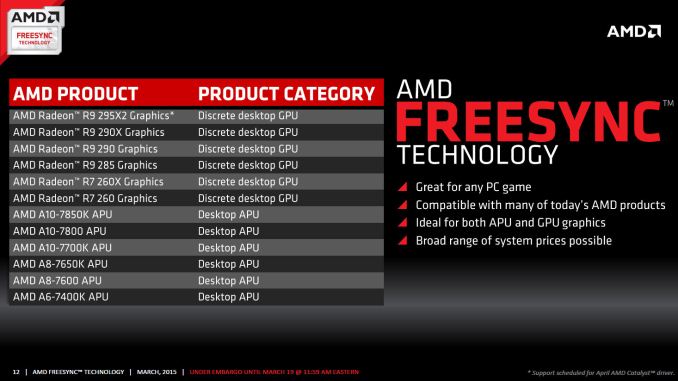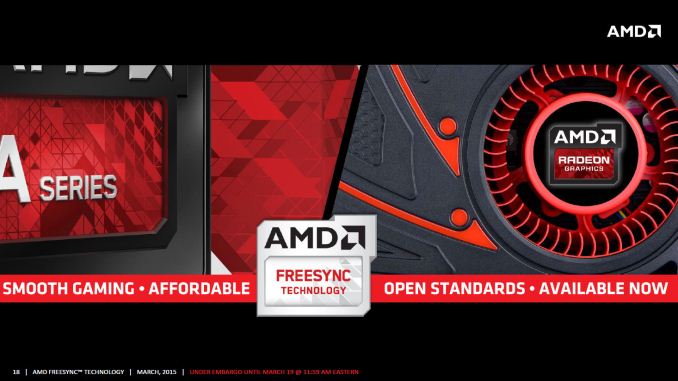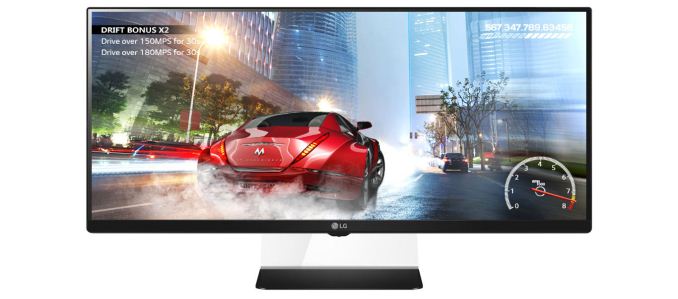The AMD FreeSync Review
by Jarred Walton on March 19, 2015 12:00 PM ESTClosing Thoughts
It took a while to get here, but if the proof is in the eating of the pudding, FreeSync tastes just as good as G-SYNC when it comes to adaptive refresh rates. Within the supported refresh rate range, I found nothing to complain about. Perhaps more importantly, while you’re not getting a “free” monitor upgrade, the current prices of the FreeSync displays are very close to what you’d pay for an equivalent display that doesn’t have adaptive sync. That’s great news, and with the major scaler manufacturers on board with adaptive sync the price disparity should only shrink over time.
The short summary is that FreeSync works just as you’d expect, and at least in our limited testing so far there have been no problems. Which isn’t to say that FreeSync will work with every possible AMD setup right now. As noted last month, the initial FreeSync driver that AMD provided (Catalyst 15.3 Beta 1) only allows FreeSync to work with single GPU configurations. Another driver should be coming next month that will support FreeSync with CrossFire setups.
Besides needing a driver and FreeSync display, you also need a GPU that uses AMD’s GCN 1.1 or later architecture. The list at present consists of the R7 260/260X, R9 285, R9 290/290X/295X2 discrete GPUs, as well as the Kaveri APUs – A6-7400K, A8-7600/7650K, and A10-7700K/7800/7850K. First generation GCN 1.0 cards (HD 7950/7970 or R9 280/280X and similar) are not supported.
All is not sunshine and roses, however. Part of the problem with reviewing something like FreeSync is that we're inherently tied to the hardware we receive, in this case the LG 34UM67 display. Armed with an R9 290X and running at the native resolution, the vast majority of games will run at 48FPS or above even at maximum detail settings, though of course there are exceptions. This means they look and feel smooth. But what happens with more demanding games or with lower performance GPUs? If you're running without VSYNC, you'd get tearing below 48FPS, while with VSYNC you'd get stuttering.
Neither is ideal, but how much this impacts your experience will depend on the game and individual. G-SYNC handles dropping below the minimum FPS more gracefully than FreeSync, though if you're routinely falling below the minimum FreeSync refresh rate we'd argue that you should lower the settings. Mostly what you get with FreeSync/G-SYNC is the ability to have smooth gaming at 40-60 FPS and not just 60+ FPS.
Other sites are reporting ghosting on FreeSync displays, but that's not inherent to the technology. Rather, it's a display specific problem (just as the amount of ghosting on normal LCDs is display specific). Using higher quality panels and hardware designed to reduce/eliminate ghosting is the solution. The FreeSync displays so far appear to not have the same level of anti-ghosting as the currently available G-SYNC panels, which is unfortunate if true. (Note that we've only looked at the LG 34UM67, so we can't report on all the FreeSync displays.) Again, ghosting shouldn't be a FreeSync issue so much as a panel/scaler/firmware problem, so we'll hold off on further commentary until we get to the monitor reviews.
One final topic to address is something that has become more noticeable to me over the past few months. While G-SYNC/FreeSync can make a big difference when frame rates are in the 40~75 FPS range, as you go beyond that point the benefits are a lot less clear. Take the 144Hz ASUS ROG Swift as an example. Even with G-SYNC disabled, the 144Hz refresh rate makes tearing rather difficult to spot, at least in my experience. Considering pixel response times for LCDs are not instantaneous and combine that with the way our human eyes and brain process the world and for all the hype I still think having high refresh rates with VSYNC disabled gets you 98% of the way to the goal of smooth gaming with no noticeable visual artifacts (at least for those of us without superhuman eyesight).
Overall, I’m impressed with what AMD has delivered so far with FreeSync. AMD gamers in particular will want to keep an eye on the new and upcoming FreeSync displays. They may not be the “must have” upgrade right now, but if you’re in the market and the price premium is less than $50, why not get FreeSync? On the other hand, for NVIDIA users things just got more complicated. Assuming you haven’t already jumped on the G-SYNC train, there’s now this question of whether or not NVIDIA will support non-G-SYNC displays that implement DisplayPort’s Adaptive Sync technology. I have little doubt that NVIDIA can support FreeSync panels, but whether they will support them is far less certain. Given the current price premium on G-SYNC displays, it’s probably a good time to sit back and wait a few months to see how things develop.
There is one G-SYNC display that I’m still waiting to see, however: Acer’s 27” 1440p144 IPS (AHVA) XB270HU. It was teased at CES and it could very well be the holy grail of displays. It’s scheduled to launch next month, and official pricing is $799 (with some pre-orders now online at higher prices). We might see a FreeSync variant of the XB270HU as well in the coming months, if not from Acer than likely from some other manufacturer. For those that work with images and movies as well as playing games, IPS/AHVA displays with G-SYNC or FreeSync support are definitely needed.
Wrapping up, if you haven’t upgraded your display in a while, now is a good time to take stock of the various options. IPS and other wide viewing angle displays have come down quite a bit in pricing, and there are overclockable 27” and 30” IPS displays that don’t cost much at all. Unfortunately, if you want a guaranteed high refresh rate, there’s a good chance you’re going to have to settle for TN. The new UltraWide LG displays with 75Hz IPS panels at least deliver a moderate improvement though, and they now come with FreeSync as an added bonus.
Considering a good display can last 5+ years, making a larger investment isn’t a bad idea, but by the same token rushing into a new display isn’t advisable either as you don't want to end up stuck with a "lemon" or a dead technology. Take some time, read the reviews, and then find the display that you will be happy to use for the next half decade. At least by then we should have a better idea of which display technologies will stick around.













350 Comments
View All Comments
Midwayman - Thursday, March 19, 2015 - link
If you have a display with backlight strobing (newest light boost, benq blur reduction, etc) the difference is readily apparent. Motion clarity is way way way better than with out. The issue is its like a CRT and strobbing is annoy at low rates. 75hz is about the absolutely min, but 90hz and above are better. I doubt any of the displays support strobing and adaptive sync at the same time currently, but when you can push the frames, its totally worth it. The new BenQ mentioned in the article will do both for example (Maybe not at the same time.) That way you can have adaptive sync for games with low FPS and strobing for games with high fps.darkfalz - Thursday, March 19, 2015 - link
Games at 100+ FPS look much smoother. Think of it like perfect motion blur. If you can keep your game between 72-144 Hz it's gaming nirvana.eddman - Thursday, March 19, 2015 - link
I'm not a fan of closed, expensive solutions, but this hate towards g-sync that some here are showing is unwarranted.nvidia created g-sync at a time where no other alternative existed, so they created it themselves, and it works. No one was/is forced to buy it.
It was the only option and those who had a bit too much money or simply wanted the best no matter what, bought it. It was a niche market and nvidia knew it.
IMO, their mistake was to make it a closed, proprietary solution.
Those consumers who were patient can now enjoy a cheaper and, in certain aspects, better alternative.
Now that DP adaptive-sync exists, nvidia will surly drop the g-sync hardware and introduce a DP compatible software g-sync. I don't see anyone buying a hardware g-sync monitor anymore.
Murloc - Thursday, March 19, 2015 - link
you don't understand the hate because you think nvidia will drop g-sync immediately.It's likely you're right but it's not a given.
Maybe it will be a while before the market forces nvidia to support adaptive sync.
MikeMurphy - Thursday, March 19, 2015 - link
nVidia will protect manufacturers that invested resources into G-Sync. They will continue support for G-Sync and later introduce added support for Freesync.ddarko - Thursday, March 19, 2015 - link
The fact that only AMD cards work with Freesync now is not because Freesync is closed but because Nvidia refuses to support it. It takes a perverse kind of Alice in Wonderland logic to use the refusal of certain company to support an open standard in its hardware as proof that the open standard is in fact "closed."Freesync is open because it is part of the "open" Displayport standard and any display and GPU maker can take advantage of it by supporting that relevant Displayport standard (because use of the Displayport standard that Freesync is part of is free). Nvidia's Gsync is "closed" because Nvidia decides who and on what terms gets to support it.
Whatever the respective technical merits of Freesync and Gsync, please stop the trying to muddy the water with sophistry about open and closed. Nvidia GPU can work with Freesync monitors tomorrow if Nvidia wanted it - enabling Freesync support Nvidia a dime of licensing fees or requirement the permission of AMD or anyone else. The fact that they choose not to support it is irrelevant to the definition of Displayport 1.2a (of which Freesync is a part of) as an open standard.
mrcaffeinex - Thursday, March 19, 2015 - link
Are NVIDIA's partners able to modify their cards BIOS and/or provide customized drivers to support FreeSync or do they have to rely on NVIDIA to adopt the feature? I know different manufacturers have made custom cards in the past with different port layouts and such. I never investigated to see if they required a custom driver from the manufacturer, though. Is it possible that this could be an obstacle that an EVGA, ASUS, MSI, etc. could overcome on their own?JarredWalton - Thursday, March 19, 2015 - link
It would at the very least require driver level modifications, which the card manufacturers wouldn't be able to provide.chizow - Thursday, March 19, 2015 - link
How is this even remotely a fact when AMD themselves have said Nvidia can't support FreeSync, and even many of AMD's own cards in relevant generations can't support it? Certainly Nvidia has said they have no intention of supporting it, but there's also the possibility AMD is right and Nvidia can't support it.So in the end, you have two effectively closed and proprietary systems, one designed by AMD, one designed by Nvidia.
iniudan - Thursday, March 19, 2015 - link
Nvidia cannot use FreeSync as it is AMD implementation of VESA's Adaptive Sync, they have to come up with their own implementation of the specification.